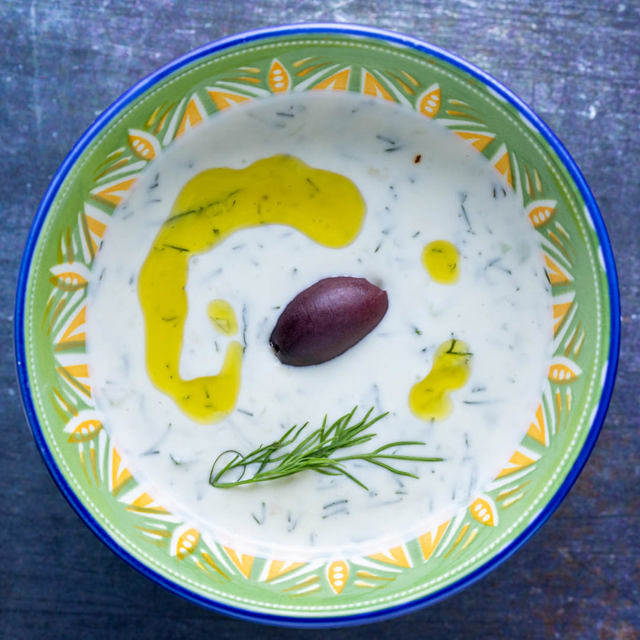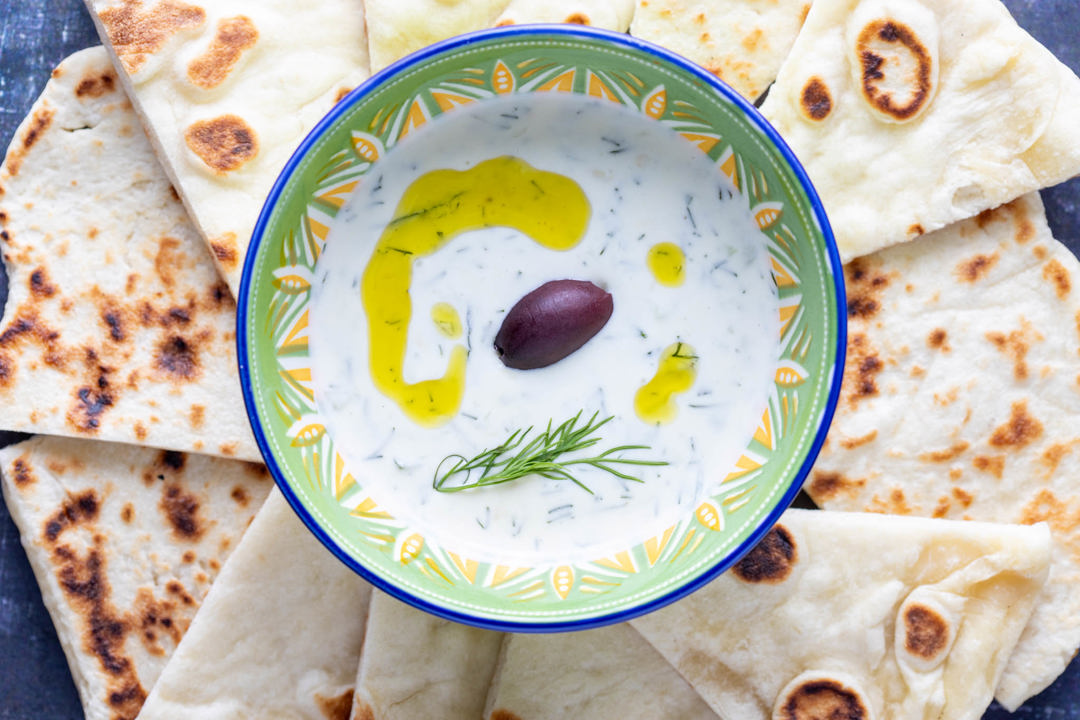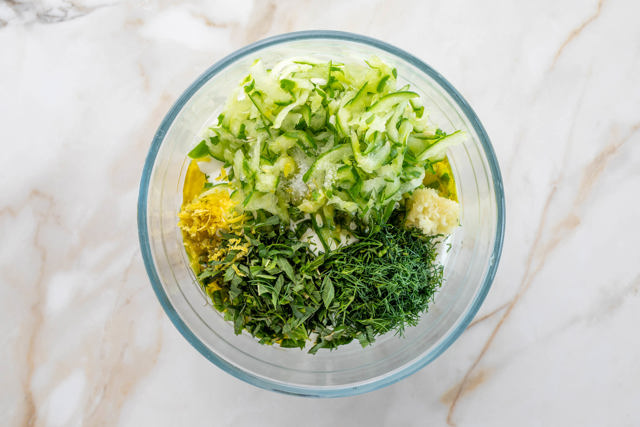Originating from Greece, tzatziki sauce (or dip!) is a creamy, tangy condiment that adds a refreshing burst of herby garlicky flavour to grilled meats and is often served as part of a meze spread, eaten with things like Greek Pita Bread or fritters.
One of the most appealing aspects of tzatziki sauce is its simplicity. With just a handful of common ingredients and some fresh herbs, you can make tzatziki in no time - perfect for those hot and busy summer nights; grill some meat and have a simple green salad and put some of the sauce on top for a complete meal.
Whether you're serving it as a dip for fresh vegetables or pita bread, or using it as a topping for grilled meats or falafel, tzatziki adds a great touch to any meal.
The yogurt base provides a creamy texture, while the grated cucumber adds a subtle crunch and a hint of freshness. Garlic infuses the sauce with a pungent aroma and dill and mint pair perfectly with the lemon juice to round out the flavour.
Not only is tzatziki sauce delicious, but it's also packed with nutrients. Yogurt is a good source of protein and probiotics, which are beneficial for gut health. Cucumber adds hydration and vitamins, while garlic is believed to have various health benefits, including boosting the immune system.
What is Tzatziki sauce?
Tzatziki is a creamy and tangy Greek condiment made from Greek yogurt, cucumber, garlic, olive oil, and herbs. It offers a refreshing tanginess with a hint of garlic, perfect for dipping or as a topping for various dishes. It's commonly eaten with lean grilled proteins or eaten as part of a meze spread. It works very well as a replacement for mayonnaise in rolls, too - give it a go!
Tzatziki ingredients
- Greek Yoghurt - the base of the sauce/dip, preferably use full fat just because the taste and texture is better. Definitely don't use a flavoured or sweetened yoghurt.
- Cucumber - I use a whole Lebanese/Persian cucumber, because they have thin skin and soft seeds. The default quantity calls for 250g, which is one good sized cucumber. If you use a cucumber with a thick skin, you should peel it before grating. If it has large, firm seeds, then, deseed it by halving lengthways and using a spoon to scrape out the seeds. They won't grate and will e firm in the sauce.
- Garlic - 1 or 2 cloves, depending on size and how much garlic taste you want.
- Lemon - one average sized lemon is about all you need. We use both the juice and the zest.
- Salt
- Extra virgin olive oil - use a good, strong EVOO, preferably Greek if you can get it.
- Herbs - dill and mint.
How to make Tzatziki
Mis en place - prepare your ingredients. Pick the mint leaves and discard the stems, and remove the thicker parts of the dill stems. Finely slice the herbs. Mince the garlic. Zest the lemon. Grate the cucumber and remove the water from it - see instructions below on how to do this.
Combine and mix - combine the garlic, lemon juice & zest, salt, extra virgin olive oil, dill and mint (1) with the yoghurt. Stir well until combined (2).
Tips
- Use a Lebanese/Persian cucumber. The seeds and skin are soft. If you're using a cucumber with thick skin, peel it. If it has firm seeds, halve the cucumber and remove them before grating.
- Use the creamiest Greek yoghurt that you can find. Not all brands are equal and the texture can vary. If you can get it, use a goats or sheep milk yoghurt, as this is traditionally what's used in Greece.
- If you want a bit of pep, add a pinch of red pepper flakes. It's not traditional, but it works well.
How to remove the water from the cucumber
It's important to remove excess water from the cucumber. Cucumber is very watery and without doing this, the sauce will split.
- Spread a clean tea towel flat on your work surface.
- Place the grated cucumber in the centre of the towel.
- Gather the corners of the towel together, forming a pouch around the cucumber.
- Hold the gathered ends tightly with one hand while using the other hand to twist and squeeze the towel, applying gentle pressure to extract the water from the cucumber.
- Continue twisting and squeezing until no more water drips from the towel. Carefully open the towel and transfer the wrung-out cucumber to the yoghurt.
What to serve with Tzatziki
- Lean, grilled protein such as steak, lamb chops or chicken breast. Perfect with Greek Marinated Chicken Breast!
- Falafel.
- Gyros/Souvlaki.
- Greek Pita Bread
- Vegetable sticks, like carrots, cucumber and celery.

Tzatziki
| Prep | Total |
|---|---|
| 10 mins | 10 mins |
- 1.5 cups Greek yoghurt about 450g - use unsweetened, full fat, see note 1
- 3/4 cup grated cucumber 1 medium whole Lebanese/Persian cucumber (XXXg) - see note 2
- Juice + zest of 1 lemon 40ml juice is needed
- 2 tbsp extra virgin olive oil
- 1-2 garlic cloves, minced depending on how much garlic you like - see note 3
- 4 tbsp mint and/or dill, finely sliced I use 2 tbsp of each - see note 4
- 1/2 tsp salt or to taste
- Yoghurt - add the yoghurt to a mixing bowl.
- Cucumber - spread a clean tea towel flat on your bench and place the grated cucumber in the centre. Gather towel corners to form a pouch around the cucumber, and twist tightly while applying pressure to squeeze water from the cucumber. Open the towel and place the cucumber into the yoghurt.
- Add everything else - add the lemon juice and zest, garlic (add 1 clove first and gradually add more until you have as much as you'd like), mint and dill, extra virgin olive oil and salt. Stir well to combine.
- Yoghurt - preferably use full fat, but make sure the yoghurt is unsweetened and unflavoured. You can make this with "light" or fat reduced yoghurt, but the taste with the full fat is noticably better. If you can get it, use a goats or sheep milk yoghurt, as this is traditionally what's used in Greece.
- Cucumber - Lebanese/Persian cucumbers are low in water and have edible seeds. If you're using cucumber with a thick skin, peel it first. If you have hard seeds, you'll need to halve the cucumber and remove them. It's important to remove excess water from the cucumber - it prevents the Tzatziki from splitting.
- Garlic - 1-2 cloves as a guide, depending on the size of your cloves and your tolerance for garlic. I suggest adding one clove and if you feel it needs more, gradually add more.
- Herbs - if you don't want to buy both, you can just use one or the other.






















